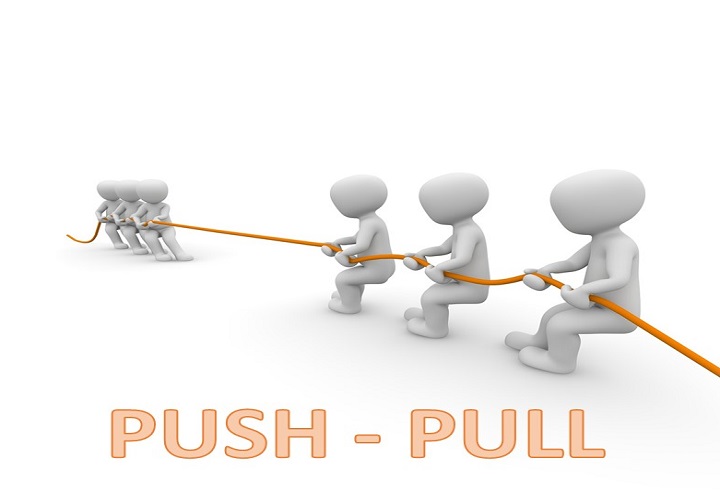Introduction
Physics is a branch of science that deals with the study of matter and energy and how they interact with each other. In the world of physics, the concepts of push and pull play a crucial role in understanding the physical properties of objects and the forces that affect their motion. In this article, we will explore the basics of push and pull in physics and their applications in real-life scenarios.
What is Push and Pull in Physics?
Push and pull are two fundamental concepts in physics that describe the forces that act upon objects. Push is a force that moves an object away from the force’s source, while pull is a force that draws an object towards its source. In simpler terms, a push is an action that causes an object to move away from something, while a pull is an action that causes an object to move towards something.
In physics, the terms “push” and “pull” are often used interchangeably with the terms “compression” and “tension.” Compression refers to a force that pushes an object together, while tension refers to a force that pulls an object apart.
How Does Push and Pull Affect Objects?
Push and pull forces play a crucial role in determining how objects move in the physical world. When an object experiences a push or pull force, it responds by either accelerating or decelerating. The amount of force applied to an object determines how much it accelerates or decelerates.
For instance, imagine pushing a toy car across a table. The amount of force applied to the car will determine how fast it moves and how far it goes. Similarly, when pulling an object, the force applied will determine how much it moves towards the source of the force.
Newton’s Laws of Motion and Push/Pull Forces
Isaac Newton’s laws of motion provide a comprehensive framework for understanding the role of push and pull forces in the physical world. Newton’s first law states that an object at rest will remain at rest, and an object in motion will continue moving in a straight line at a constant speed unless acted upon by an external force.
Newton’s second law states that the acceleration of an object is directly proportional to the net force applied to it and inversely proportional to its mass. In simpler terms, the amount of force applied to an object determines how much it accelerates, while its mass determines how much it resists acceleration.
Newton’s third law states that for every action, there is an equal and opposite reaction. In other words, every push or pull force creates an equal and opposite force in the opposite direction.
Applications of Push and Pull Forces
Push and pull forces are ubiquitous in the physical world, and their applications are numerous. Some common examples of push and pull forces in everyday life include:
1. Friction
Friction is a force that opposes motion between two surfaces in contact. When you push a book across a table, the force of friction acts against the push force, making it harder to move the book. Similarly, when you pull a sled across the snow, the force of friction between the sled and the snow makes it harder to move.
2. Magnetism
Magnetism is a force that pulls or pushes objects that have a magnetic field. For instance, a magnet can pull a metal object towards it or push it away, depending on the orientation of the magnet.
3. Gravity
Gravity is a force that pulls objects towards each other. It is what keeps us firmly planted on the ground and what keeps planets in orbit around the sun.
4. Electrostatic Forces
Electrostatic forces are push and pull forces that occur between charged particles. For instance, opposite charges attract each other, while like charges repel each other.
Conclusion
Push and pull forces play a crucial role in the physical world, determining how objects move and interact with each other. From friction and magnetism to gravity and electrostatic forces, the applications of push and pull forces are numerous and varied.
By understanding the basics of push and pull in physics, we can better understand the world around us and the forces that shape our everyday lives. Whether we are pushing a toy car across a table or pulling a sled through the snow, the principles of push and pull are always at play.
FAQs
1. What is the difference between push and pull forces?
Ans. Push is a force that moves an object away from the force’s source, while pull is a force that draws an object towards its source.
2.What are some real-life applications of push and pull forces?
Ans. Push and pull forces are ubiquitous in the physical world and can be seen in everything from friction and magnetism to gravity and electrostatic forces.
3. How do push and pull forces affect an object’s motion?
Ans. Push and pull forces can cause an object to accelerate or decelerate depending on the amount of force applied and the object’s mass.
4. What are Newton’s laws of motion, and how do they relate to push and pull forces?
Ans. Newton’s laws of motion provide a comprehensive framework for understanding the role of push and pull forces in the physical world.
5. Why is it important to understand push and pull forces?
Ans. By understanding push and pull forces, we can better understand the world around us and the forces that shape our everyday lives. This knowledge can have practical applications in fields ranging from engineering to medicine.

